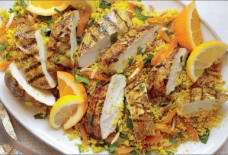Author Randa Jarrar draws inspiration from Arabs around the world for her latest book
At one of the public readings of stories from her new book – Him, Me, Muhammad Ali – Palestinian-American writer Randa Jarrar was asked by a member of the audience whether she knew a woman who was half-goat.
The unusual question came after she had discussed the last story in her provocative collection of short stories, in which she skilfully explores the burdens of growing up an Arab in America using a character who is half human-half animal.
She laughs as she remembers the encounter. “I want people to think that everything I write has actually happened,” she says, but adds: “I don’t know any half-goat people, sorry.”
Jarrar, a fiction writer and creative-writing professor in Fresno, California, manages to imbue her stories and characters with unabashed satire and biting language, melded with an expansive, imaginative geography.
She was born in the US to a Palestinian father and Egyptian mother, and grew up in Cairo and Kuwait. This diasporic upbringing informed her critically acclaimed debut novel A Map of Home (2008), and in this new, beautifully crafted collection she moves seamlessly from Istanbul to Sydney to Seattle, with stories featuring colourful characters from a variety of Arab backgrounds.
“I think of ‘hyphenated Arabs’, Arabs and people of colour when I am writing,” she says. “Me wanting to ‘come out’ as Arab in my writing is my way to reach my family, my community and it’s the stuff I wanted to read – growing up.”
In 2010, just months before the Arab Spring, the Hay Festival of Literature & Arts, an acclaimed annual event in Wales, named her one of the best 39 writers of Arab origin under the age of 40.
With the publication of Him, Me, Muhammad Ali, Jarrar hopes to expand the literary representations of Arabs.
“I think of myself first and foremost as a fiction writer,” she says, before adding “there’s a lot of work that I put into creating my characters [to make the fiction] seem real”. An example of this approach can be seen inTestimony of Malik, Prisoner #287690. The story, about an interrogation by a Turkish military commander of a Palestinian bird, a kestrel, which trace the violent politics of occupation in Gaza and beyond. The collection’s title storyHim, Me, Muhammad Ali is a poignant elegy about a daughter’s troubled relationship with her father as she searches for a meaningful place to scatter his ashes but instead ends up mourning her mother.
Jarrar uses the legendary 1974 boxing match between Muhammad Ali and George Foreman in Zaire – the so-called “Rumble in the Jungle” – as the background against which the daughter’s parents met, before the action shifts to Alexandria, Cairo, Sydney and New York, tackling issues including playground racism and Islamic sermons with searing imagery. “We are just everywhere, on every continent,” Jarrar says, referring to the long history of Arab migration to the west. “I’m thinking of characters and how they move. I draw and think of sentences as sites and places.”
Another prominent thread binding the 200-page collection is her juxtaposition of female characters, as she traces their travails of navigating issues such as sex, body shaming and friendship. In How can be I of use to you?, Jarrar explores the frailties of an older Egyptian feminist and her young protégé, a tale that evokes shades of the famed Egyptian literary icon Nawal El Saadawi.
“I am trying to talk about pairs of women, but at the same time getting away from the idea of binaries,” she says. “I had pairs of sisters, mothers and daughters, older and younger feminists.”
Such dynamics are responsible for many of the searing images and big emotions offered in the collection.
Jarrar breathes life into these brooding relationships with sentences that are tender and funny while grappling with heavy themes such as domestic violence and infidelity.
“I think I am looking at maternal figures in all of those stories because I think it’s a role that has the heaviest expectations culturally,” she says.
A mother herself, Jarrar dedicates her latest work to her son – a fitting dedication given that this endearing book, and its vulnerable characters, indelibly leaves the reader with an intimate sense of love and loss.


